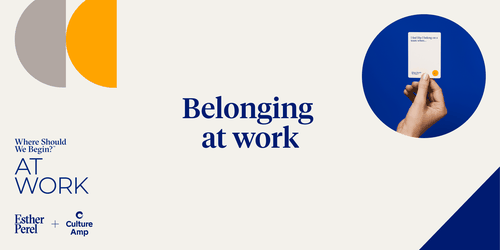
Culture Amp’s magic 8 ball: How we predict work will change in 2026
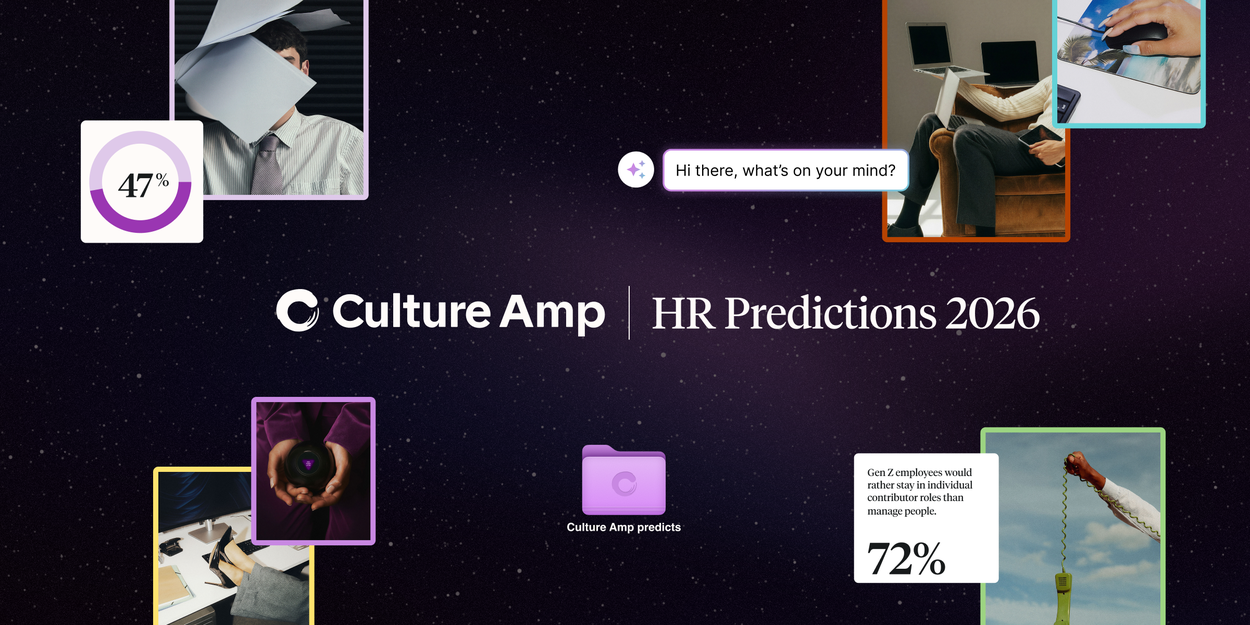
Written by

Senior Data Journalist, Culture Amp

Director of People Science Research, Culture Amp
What do KPop Demon Hunters and the workplace have in common? More than you’d think. The surprise global hit of 2025 reminded us of the importance of being authentic, shadows and all. Don’t hide the messy parts, it said. Own them. And we think that’s exactly what the world of work needs in 2026.
It’s harder than ever to tell what’s true online and otherwise. Is that a hot take or a bot take? A genuine news story or AI slop? In moments like these, we look to the data to show us what’s really going on.
What we saw while building these 2026 predictions was hard to swallow but important to acknowledge. Engagement continues to slip, career pathways feel jammed, and managers are stretched thin.
Last year, we predicted that in 2025, the employer-employee standoff would continue – and it has. But in 2026, the pendulum will have swung decisively back toward employers, and employees are feeling the pain of having lost leverage. As a light-hearted example, David Kingsley, CPO of Illumio, pointed out that “despite being a prominent feature of office planning 10 years ago, nap pods are (fortunately!) no longer on the list of things for which organizations look”. Naps at work were so 2010.
Jokes aside, this isn’t the doom-and-gloom scenario that it might initially seem. It calls for humility; for us to be clear-eyed about the challenges while still holding space for optimism. Within every one of our predictions is an opportunity: to create more transparency, redefine leadership, cultivate sustainable performance, or turn side hustles into signals of growth.
Everywhere you look, AI dominates the conversation. AI is amplifying tensions, reshaping what counts as work, and undoing systems once considered untouchable. But it’s also unlocking new ways of understanding and supporting people. It’s the throughline in every one of our predictions this year.
And while we’re predicting the future, we’ll close with a set of AI curveball predictions. They’re playful and somewhat outlandish – they’re us taking delight in the AI uncertainty ahead. Sometimes the best way forward is to find levity in the challenge of owning the shadow, telling the truth, and continuing to strive for incremental improvements that shape the course of the future.
Prediction 1. EVP to LeaVeP
Companies will embrace culture transparency to move job-huggers out and fresh talent in.
Job hugging is having a moment. Employees aren’t exiting at the same rate they were before, perhaps because the job market is tight and there are fewer external roles open. We’re seeing what we’ve started to call a talent jam – when employees who would have otherwise left stay put, blocking the growth and mobility opportunities for those ready to move forward.
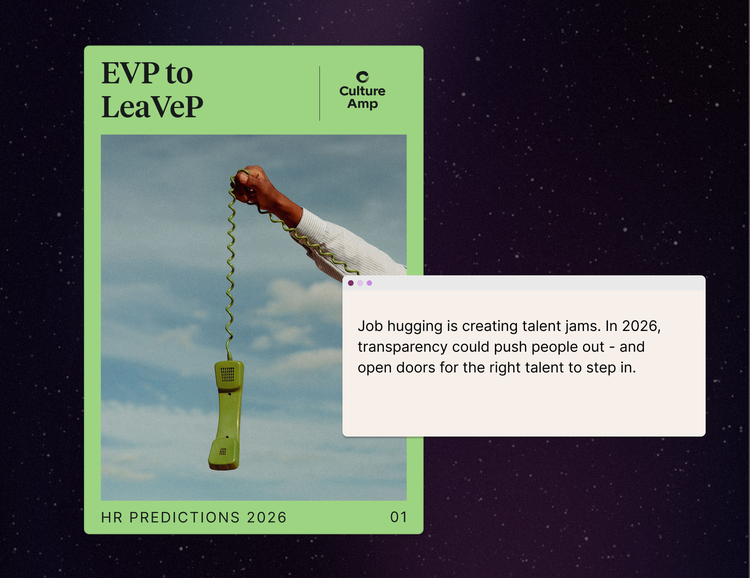
Historically, when companies share survey results, they tend to spotlight what’s working and sidestep what’s not. Mid-year 2025, our global benchmarks revealed the high-favorability (90%+) aspects of the employee experience that companies proudly build into their Employee Value Propositions (EVP): good people doing important, goal-oriented work.

But our data also points to the undercurrent of the employee experience that companies rarely recognize: low accountability, lower capacity to act, and high stress (all were at or below 50% agreement).
So how do companies break the talent jams created by job hugging? We’re predicting HR teams will lean into repulsion marketing. This is a marketing tactic used to highlight the things that might turn away the wrong people, so the right people feel even more drawn in. If we’re being cheeky, it’s shifting from the EVP to the LeaVeP.
What if, in 2026, more companies make transparency their focus? By naming both the perks and the pain points using actual data, companies can repel those who plan to leave, invite in those who remain dedicated, and create space for careers to move again.
We’ve already seen big players dip their toes into this strategy. For example, AT&T’s CEO told employees resisting a five-day office return that they might want to rethink their fit. The Washington Post’s CEO told staff that if they weren’t aligned with the company’s reinvention, they should go elsewhere. Were those talent-jam plays? Or just blunt attempts to push back on resistance to change? Either way, they signal a shift: Transparency itself could be a competitive advantage.
If you have to sell people on a fantasy to get them in the door, you’ll spend twice as long managing their disillusionment once they’re inside. Real transparency helps people who are aligned stay and gives everyone else permission to go.
Nicole Eisdorfer
Culture First Chapter Lead in Denver, CO, USA
Of course, transparency about the employee experience requires a company to measure it first. And what companies are measuring has been changing in 2025, setting the stage for a shift in 2026.
Prediction 2. Performance theater
Passive monitoring will redefine success, rewarding visibility over value until feedback systems catch up.
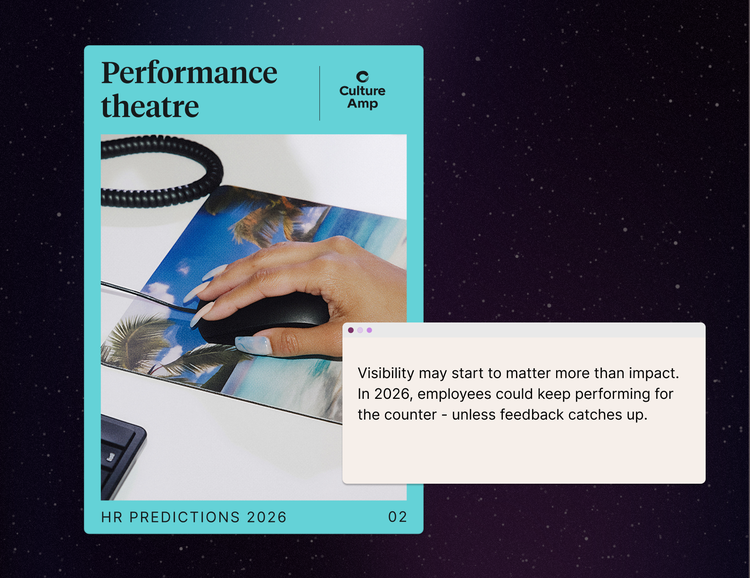
Our data shows a growing share of employees don’t believe their performance processes capture the full scope of their contributions.

And this gap has been widening. If people already feel overlooked by traditional reviews, imagine how much that sense of invisibility grows when performance is reduced to keystroke counts or app-usage trackers.
When people don’t feel recognized for their real work, they start leaning into the work that will be recognized (or at least the work that’s visible). Cue performance theater! Reporting from Asana shows that two-thirds of employees already admit to engaging in productivity theater, which is working in ways that look productive, even if the output isn’t meaningful. This is only increasing as the use of employee monitoring tools continues to spread.
Unfortunately, in a world of passive monitoring, the risk is that employees begin to live-action role-play (LARP) their jobs. Sociologist William Bruce Cameron warned us that in a world where “Not everything that counts is counted, and not everything that is counted counts,” our richest signals are easily lost. Human feelings, culture, values, identity, and community matter deeply but are not easily quantified.
We predict that in 2026, this gap will continue to widen unless leaders rebalance their approach to measuring performance. Passive monitoring alone cannot capture the full picture. Companies that integrate human-centered feedback systems, such as upward feedback, 360-degree feedback, and reflective one-on-ones, will build a more trusted and comprehensive view of employees’ contributions.
Data from employee monitoring only gets a company to the point of knowing something is wrong. It doesn’t provide direction as to how to solve that problem, which is considerably more important. Leaders need data that dips into the ‘why’ for that.
Eleni Teichmann
Lead People Scientist in EMEA
As companies rethink their processes, AI tools are also evolving. They can do more than count clicks, track minutes in apps, and summarize meeting notes. Our next prediction examines how people teams can leverage AI to enhance the employee experience while maintaining a human-first approach.
Prediction 3. AI clocks in
As more of their function gets outsourced, HR leaders are tasked with designing an AI-augmented workforce.
Since the mainstream debut of Large Language Models (LLMs) in 2023, companies and employees have debated how AI will transform the future of work. It seems the central question shifted in 2025 from “Will AI replace jobs?” to “Which jobs will it replace – and how?”
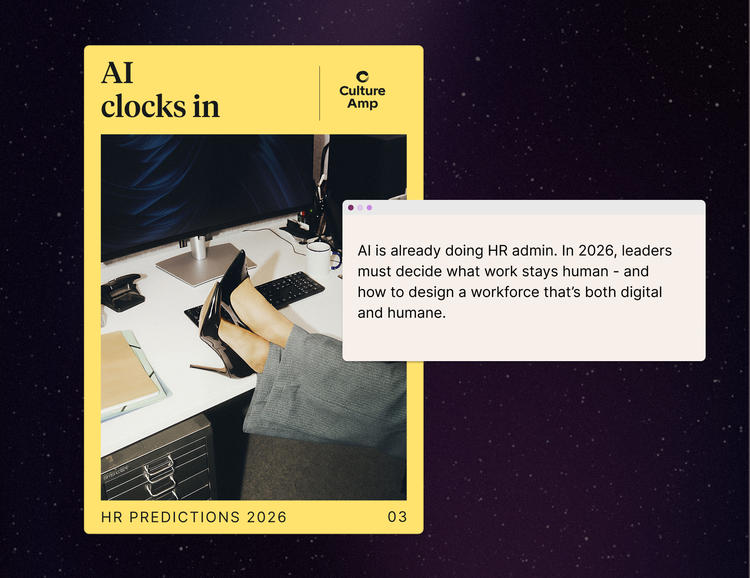
For HR, the AI shift is already well underway. Tasks like candidate screening or sourcing answers to basic HR policy questions are becoming increasingly automated. Those seemingly simple administrative tasks, though, can be deeply human.
Consider this: When an employee loses a loved one and needs to understand their company’s bereavement policy, a chatbot can answer in seconds maybe even saying all the same words HR would. But a person can take a human pause to offer compassion and convey the sense that one’s grief doesn’t need to unfold in isolation. Moments like these are precisely why HR finds itself at a crossroads with AI.
Midway through 2025, we asked HR professionals and leaders about their take on AI at work. Less than half (47%) of HR professionals believe AI will increase the perceived value of HR expertise. Two of every three expect that colleagues not already using AI for work will be left behind, and most disagree that HR should own AI strategy at all.
We know HR is automating, but leaders are hesitant to lead that automation. Behind their hesitation, we believe, lies a deeper worry about what happens when the human touch is no longer considered necessary.
In the same vein, Deloitte’s Agentic AI for HR Report outlines a split between “machine-owned” capabilities (like processing and analysis) and “human-owned” ones (like high-touch interactions, consulting leaders, and workforce planning). The future of HR will hinge on how confidently we draw and defend that line.
Of course, matters are complicated by the reality that AI is already here. And unlike humans, AI doesn’t need benefits packages or training programs. Workforce planning is becoming more digital than HR teams and strategy have had to contend with before. Anna Binder, former CPO of Asana, says that, “Companies that are committed to playing the long game in their digital workforce planning might be considering merging the functions that intersect in this area - information technology and Human Resources. Chief People & Information Officer, perhaps?”
In 2026, HR leaders will have to take center stage in reimagining a workplace and workforce that is both highly digital and human. HR will need to (re)design the relationship between humans and machines at work.
If HR doesn’t do a pre-mortem on the AI revolution, someone else will write our obituary. Our job is to defend humanity in the systems we build.
Laurie Ruettimann
HR thought leader and host of the 'Punk Rock HR' podcast
Leading into the new year, HR can start with what we already know makes a difference: using employee feedback to identify where human connection matters most and protecting those touchpoints (e.g., onboarding, development, life events, exits).
This leaves us wondering: If HR is being redefined, what about leadership itself? As AI-augmented managers step in to do more with less, we may soon face a very different kind of shortage – not of HR, but of people actually willing to lead.
Prediction 4. Rejecting the climb
Leadership pipelines will shrink as AI-augmented managers redefine what leadership means.
In the irreverent TV show The Office, Dwight Schrute openly yearns to become the “Assistant Regional Manager.” In today’s landscape, that part of Dwight’s character is coded with even more outlandishness than it was upon airing in the mid-aughts. Why? Colloquially known as “conscious unbossing,” the trend of fewer employees intending to step into management has become a phenomenon. Management and leadership roles seem to be less appealing to employees going into 2026.
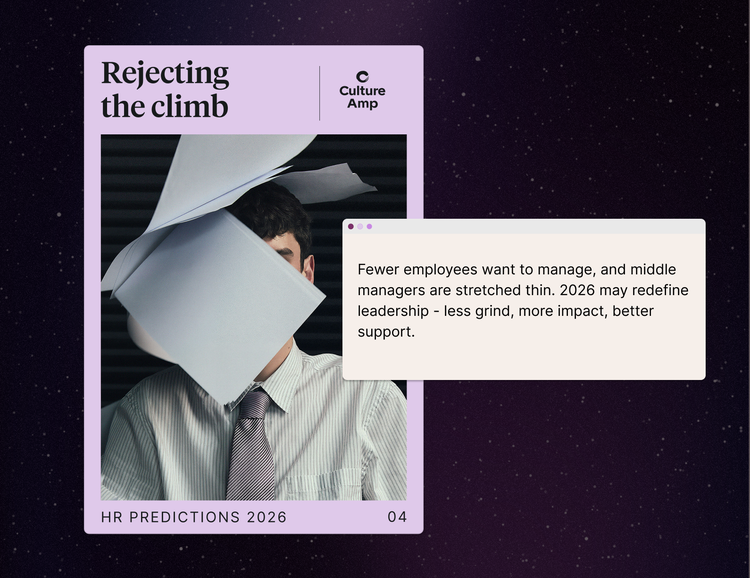
The reasons why aren’t hard to spot. Companies are flattening hierarchies. Industry titan Microsoft cut 6% of its workforce in May 2025. That was just one example of a company making a public statement about its strategy to reduce layers of management, which, of course, makes management roles feel less secure for all.
Plus, middle managers are typically caught in a bind: They’re in a “player-coach” squeeze where they’re expected to deliver their own work and support their teams.
Their workloads feel the least reasonable, they’re more stressed, and they feel the least equipped by the systems and processes they have to operate within. Middle managers are stuck between expectations from above and demands from below.
Perhaps this helps explain why 72% of Gen Z employees would rather stay in individual contributor roles than manage people. With the youngest of our workforce not seeing the appeal of management and leadership roles, we predict a leadership and management recession is coming.
What’s more, AI-augmented managers are quickly becoming the new norm, ideally meaning managers will be able to (actually) do more with less. For example, when it is engagement survey season, managers can lean on an AI Coach to synthesize feedback, flag team patterns, and generate action plans that move the needle.
During performance cycles, managers can use AI coaches for organizing performance feedback or prepping for difficult conversations. Laura McGann, CPO of Prosci, reflected that AI coaches are a way to “unburden managers so they can direct energy towards what matters most with Culture Amp tools in their pocket.” She went on to ponder what the climb might look like in its next formation, with managers and employees alike having consistent access to AI augmentation.
2026 may mark the beginning of a leadership recession, but it could also spark a leadership evolution. If fewer people are willing to manage, the answer may not be more managers, but better-supported ones. And maybe that will make the role worth aspiring to again.
Prediction 5. Side hustle renaissance
Employer leverage will spark a side hustle boom, as more workers channel discretionary effort beyond company walls.
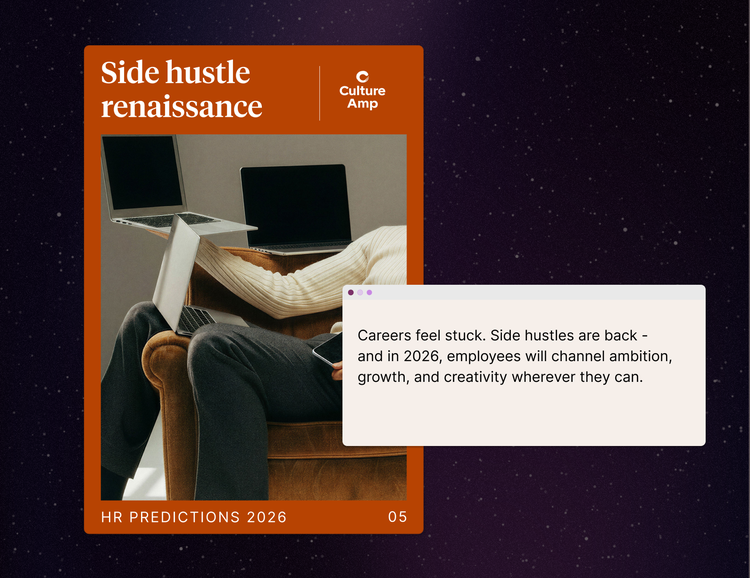
For decades, the career ideal was about climbing a ladder, one rung at a time. But our July 2025 data shows that vision is slipping away. Fewer employees feel energized by work, believe their roles use their strengths, or genuinely enjoy what they do. “My career” is fading from the cultural lexicon. Increasingly, it’s just “my day job.”
What’s more, about one in every five employees is feeling unfulfilled at work.
But even if the career is dead, it doesn’t mean ambition has died with it. Employees are still motivated and still want to grow, achieve, and push themselves. But they may very well be finding new places to channel their drive. In 2026, we predict a renaissance of the side hustle.
Side hustles once felt like extras – passion projects squeezed in after hours. We have all had a friend who sold jewelry on Etsy, drove people around in their car for extra cash, or started a niche podcast to talk about something they loved. Next year, those side hustles will move back to the main stage.
Why the renaissance? For some, it’s necessity. Wage increases are slowing, inflation is mounting, and a record number of employees are now working multiple jobs just to make ends meet. For others, it’s fulfillment. When career paths feel blocked by talent jams or by performance processes that fail to capture contributions, the side hustle offers creativity and growth that the day job doesn’t.
Upwork’s Future Workforce Index shows side hustles serving both as financial lifelines and as incubators for new skills. So, employees are building their future in parallel, not just inside company walls.
The risk for employers goes beyond distraction or waning motivation. The bigger risk is that the tables flip completely, and the job at the company itself becomes the side gig. Even with leverage on their side, employers can’t stop ambition from flowing outward.
But leaders can offer something better. The opportunity in 2026 is to make the main job feel as energizing, creative, and worth investing in as the side hustle.
L. David Kingsley, CPO of Illumio, reflects:
“We’ve called this role many things – Chief Personnel Officer, Chief Administrative Officer, Chief Human Resources Officer, and the like. But we’re in the middle of a fundamental shift in the employer/employee relationship, and in the nature of work itself.
No longer resources to be managed or cost centers to be optimized, people are the central and defining factor behind which companies lead and which fall behind. The continued evolution of our thinking begins with us and tone at the top – redefining our own roles to reflect how our people, the technologies we use, and the work we do, are evolving.”
And just as employees are reinventing ambition on their own terms, AI is rewriting work in its own unpredictable ways.
Prediction 6. AI’s wild cards
The next phase of AI at work will be weird, wild, and swift.
If there’s one thing AI is teaching us, it’s to expect the unexpected. The future of work won’t unfold in a straight line. Rather, it will zig, zag, and surprise us in ways both unsettling and exciting. The availability of AI makes predicting next year a total Magic 8 ball moment. The many AI “what ifs” remind us how much possibility still lies ahead. Even in uncertainty, we can shake things up and have a little fun.
Our top three AI wild card questions are:
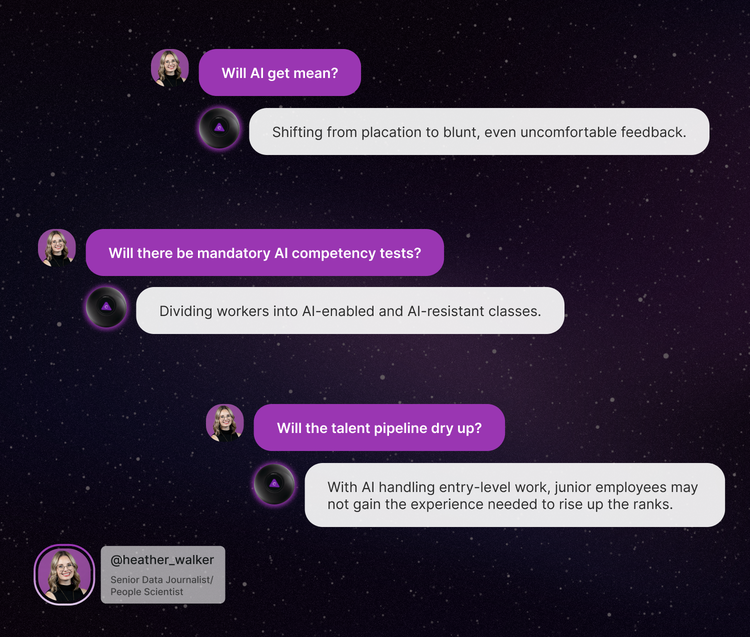
The magic 8 ball is in your court…
2026 will be a year of mash-ups: job huggers and side hustlers, AI-augmented managers and evolving definitions of performance, companies leaning into what makes them magnetic and repellent. The pendulum has swung back to employers, but the story isn’t finished.

We’ve seen this before in the culture around us. Pop culture cues (such as KPop Demon Hunters and The Office) reveal how identity, ambition, and progress aren’t linear. Human is as human does. We’re playful, stubborn, and always shifting. More change is coming, but the biggest question remains: Which role will you play?

Future-proof your organization
Get the tools to engage your workforce and drive high performance in the next year and beyond.
